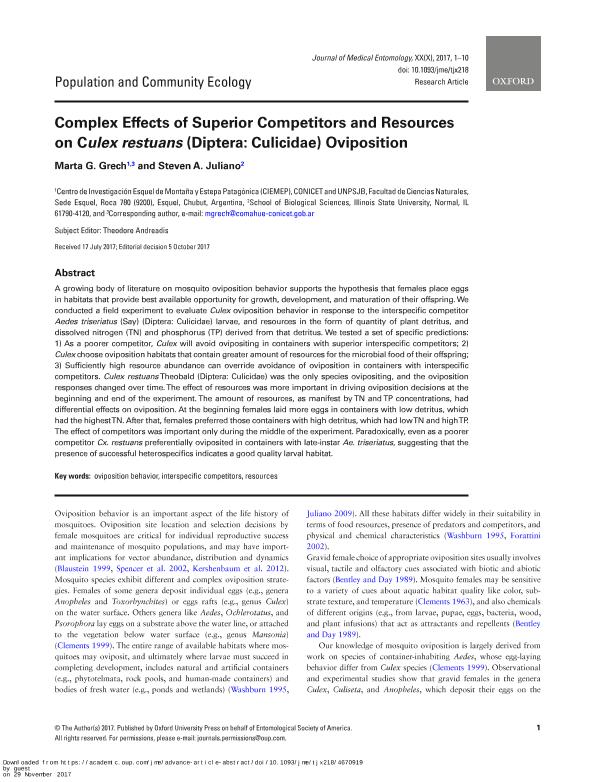Mostrar el registro sencillo del ítem
dc.contributor.author
Grech, Marta Gladys

dc.contributor.author
Juliano, Steven A
dc.date.available
2018-08-22T15:22:37Z
dc.date.issued
2018-03
dc.identifier.citation
Grech, Marta Gladys; Juliano, Steven A; Complex Effects of Superior Competitors and Resources on Culex restuans (Diptera: Culicidae) Oviposition; Entomological Society of America; Journal of Medical Entomology; 55; 2; 3-2018; 360-369
dc.identifier.issn
0022-2585
dc.identifier.uri
http://hdl.handle.net/11336/56546
dc.description.abstract
A growing body of literature on mosquito oviposition behavior supports the hypothesis that females place eggs in habitats that provide best available opportunity for growth, development, and maturation of their offspring. We conducted a field experiment to evaluate Culex oviposition behavior in response to the interspecific competitor Aedes triseriatus (Say) (Diptera: Culicidae) larvae, and resources in the form of quantity of plant detritus, and dissolved nitrogen (TN) and phosphorus (TP) derived from that detritus. We tested a set of specific predictions: 1) As a poorer competitor, Culex will avoid ovipositing in containers with superior interspecific competitors; 2) Culex choose oviposition habitats that contain greater amount of resources for the microbial food of their offspring; 3) Sufficiently high resource abundance can override avoidance of oviposition in containers with interspecific competitors. Culex restuans Theobald (Diptera: Culicidae) was the only species ovipositing, and the oviposition responses changed over time.The effect of resources was more important in driving oviposition decisions at the beginning and end of the experiment. The amount of resources, as manifest by TN and TP concentrations, had differential effects on oviposition. At the beginning females laid more eggs in containers with low detritus, which had the highestTN. After that, females preferred those containers with high detritus, which had lowTN and highTP. The effect of competitors was important only during the middle of the experiment. Paradoxically, even as a poorer competitor Cx. restuans preferentially oviposited in containers with late-instar Ae. triseriatus, suggesting that the presence of successful heterospecifics indicates a good quality larval habitat.
dc.format
application/pdf
dc.language.iso
eng
dc.publisher
Entomological Society of America

dc.rights
info:eu-repo/semantics/openAccess
dc.rights.uri
https://creativecommons.org/licenses/by-nc-sa/2.5/ar/
dc.subject
Oviposition Behavior
dc.subject
Interspecific Competitors
dc.subject
Resources
dc.subject.classification
Otras Ciencias Biológicas

dc.subject.classification
Ciencias Biológicas

dc.subject.classification
CIENCIAS NATURALES Y EXACTAS

dc.title
Complex Effects of Superior Competitors and Resources on Culex restuans (Diptera: Culicidae) Oviposition
dc.type
info:eu-repo/semantics/article
dc.type
info:ar-repo/semantics/artículo
dc.type
info:eu-repo/semantics/publishedVersion
dc.date.updated
2018-08-21T12:56:37Z
dc.journal.volume
55
dc.journal.number
2
dc.journal.pagination
360-369
dc.journal.pais
Estados Unidos

dc.journal.ciudad
Lanham
dc.description.fil
Fil: Grech, Marta Gladys. Consejo Nacional de Investigaciones Científicas y Técnicas. Centro Científico Tecnológico Conicet - Patagonia Norte. Centro de Investigación Esquel de Montaña y Estepa Patagóica. Universidad Nacional de la Patagonia "San Juan Bosco". Facultad de Ciencias Naturales - Sede Esquel. Centro de Investigación Esquel de Montaña y Estepa Patagónica; Argentina
dc.description.fil
Fil: Juliano, Steven A. University of Illinois; Estados Unidos
dc.journal.title
Journal of Medical Entomology

dc.relation.alternativeid
info:eu-repo/semantics/altIdentifier/doi/https://dx.doi.org/10.1093/jme/tjx218
dc.relation.alternativeid
info:eu-repo/semantics/altIdentifier/url/https://academic.oup.com/jme/article-abstract/55/2/360/4670919
Archivos asociados
